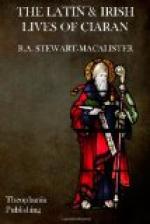The Stanzas in VG.—The metre is ae freslige. Literally: “I shall speak witness truly / though single is thy numerous train // thou shalt be a king pleasant, dignified / of Ireland this time to-morrow /// The slaying of chosen Tuathal / Moel-Garb, it was a crying without glory // thence is the choice saying / ‘it was the deed of Moel-Moire’ /// Without rout and without slaughter / he took Uisnech, it was not after an assembly // Diarmait the eminent gave / a hundred churches to God and to Ciaran.”
The Episode of Tren (VG).—This story illustrates a belief in sympathetic magic. What Tren had done to deserve this punishment is unknown, nor is the site of Cluain Iochtar identified. Possibly he had endeavoured to prevent Ciaran from founding his church; compare the story of Findian and Baeth (LL, 2624). Patrick had a dispute with a certain Trian, but the details of the story are different (TT, p. 45, ch. lxxx, etc.). It is difficult for us to put ourselves into the position of people who thought to honour their saint by telling a story about him which we should consider not only silly but immoral. But such an attempt must be tried if we are to understand anything of ancient writings, in whatever language and from whatever countries they may come down to us. Even when we read so modern and so universal an author as Shakspere we must for the moment imagine ourselves sixteenth-century Elizabethans; the more we succeed in doing so, the better do we understand what we read. So, in criticising a story like this, we must rid ourselves of all our twentieth-century prejudices, and accept it in the simple faith of those to whom it was intended to be told.
On one of the great carved crosses still to be seen in Clonmacnois—that erected in memory of Flann King of Ireland (ob. 914)—there is a panel representing an ecclesiastic and a layman holding an upright post between them. It has been plausibly conjectured that this represents the erection of the corner-post of the church, as described in our text.
XLIII. HOW CIARAN SENT A CLOAK TO SENAN (LA, VG)
The “Cloak of Senan” must have been an actual relic preserved on Inis Cathaig; tradition said that it had been floated on the river to the saint of the island, though there were various opinions as to which saint had done the miracle; it is attributed to Brigit daughter of Cu Cathrach (LL, 2399) and to Diarmait (CS, 753). For parallels to the automatic transfer of objects by water, see Plummer, VSH, i, p. clxxxvi, note 2.
XLIV. CIARAN AND THE WINE (LA, LB, VG)
The choice laid before the monks is curious, and hardly consonant with the usual spirit of abjuring the world; it may be aetiological, designed to explain, and perhaps to excuse, the opulence and temporal importance of Clonmacnois at the time when it was written. A similar but not identical story appears in the life of Munnu (VSH, ii, 227).




